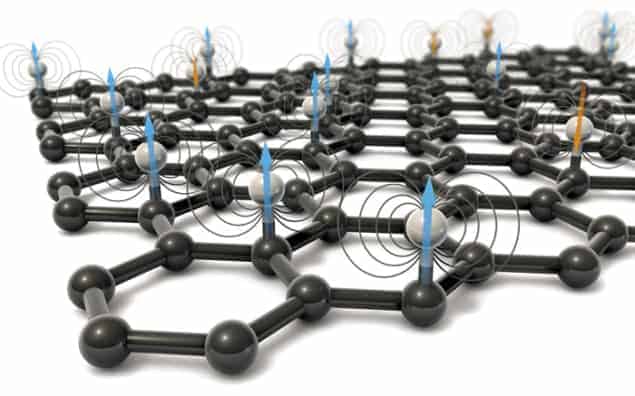
Hydrogen atoms can induce magnetism in graphene and be used to create a uniform magnetic order across the 1D material. That is the finding of researchers in Spain, France and Egypt, who also demonstrated that it is possible to atomically manipulate hydrogen atoms on graphene to control the local magnetic state.
Graphene is a sheet of carbon just one atom thick that has a number of unique properties. But it is not magnetic. “The incorporation of magnetism to the long list of graphene capabilities has been pursued since its first isolation in 2004,” says Ivan Brihuega of the Autonomous University of Madrid. “The use of spin as an additional degree of freedom would represent a tremendous boost to the versatility of graphene-based devices.”
Sublattice imbalances
The honeycomb structure of graphene is made up of two hexagonal sublattices, and magnetism can occur when there is an imbalance between the sublattices. While it is theoretically possible, modifying graphene in a controlled way to induce magnetism has proved challenging. When it has been done, it has been difficult to determine the atomic origin of the magnetic moments.
In theory it should be possible to create magentic graphene through hydrogenation. When a hydrogen atom is added to graphene, it binds to one of the carbon atom’s atomic orbitals – the pz-orbital. This causes an imbalance in the spin states, which in turn creates a net magnetic moment. To address previous challenges, Brihuega and colleagues investigated the impact of single hydrogen atoms on graphene sheets. “We directly visualize, at the atomic scale, how graphene magnetism emerges after the adsorption of a specific hydrogen atom,” he explains.
The team used scanning tunnelling microscopy (STM) to view the hydrogen atoms and examine the energy states. When a single atom was absorbed on graphene, the researchers observed the production of a local magnetic moment. This was characterized by a spin-polarized state at the Fermi energy level, with two narrow peaks in the density of states, as the theory predicted.
Twin peaks
To demonstrate that the split peaks are induced by magnetism, the team added hydrogen atoms to nitrogen-doped and phosphorus-doped graphene, because the magnetism in graphene is thought to be sensitive to doping. Indeed, the team found that the split peaks associated with the magnetic moment disappeared in the doped graphene. Further experiments also showed that the spin-polarized state extends several nanometres away from the hydrogen atoms, and can drive the direct coupling of magnetic moments over large distances, creating a uniform magnetic order.
When there is more than one hydrogen atom on a region of graphene, the magnetic state depends on how these atoms are attached to the sublattice. When two hydrogen atoms are absorbed on the same sublattice, they show ferromagnetic coupling. But if they are on different sublattices, the result is non-magnetic, because the two balance each other out. The researchers also found that it is possible to tailor the local magnetic state of graphene by using STM to manipulate and move individual hydrogen atoms, switching the magnetism on and off as needed.
Magnetic switch
Brihuega and colleagues showed that if you take the nonmagnetic configuration of two hydrogen atoms on on different sublattices and then remove one of them, a spin-split state immediately emerges, confirming the creation of a magnetic moment. Likewise, if the researchers started with the magnetic configuration of two hydrogen atoms on the same sublattice and then laterally moved one to the opposite sublattice, the split peaks disappeared, indicating that local magnetism had been switched off.
“Our measurements prove that the induced magnetic moments can couple at very long distances and determine the coupling rules between them,” says Brihuega. “And very importantly, we achieve the controlled manipulation of single hydrogen atoms, which demonstrates that hydrogen atoms can be used as building blocks to tailor graphene magnetism at will.”
While their experiments were performed at 5 K, Brihuega believes that room-temperature graphene magnetism will also soon be a reality. “A different question is when such magnetism could be used in a real device,” he acknowledges. “In a standard material, the normal answer would be that it will take quite some time; however, graphene has already been shown to be anything but standard, and one should not be very surprised to see such a device soon.”
The research is published in Science.



